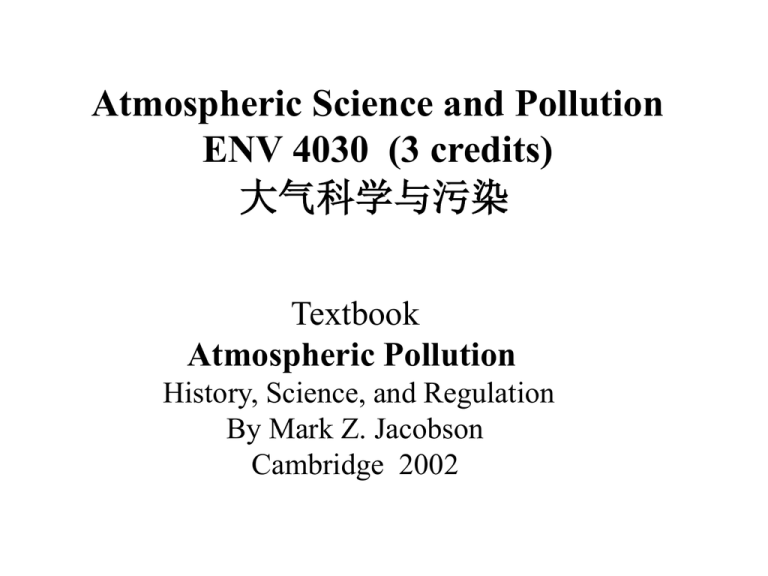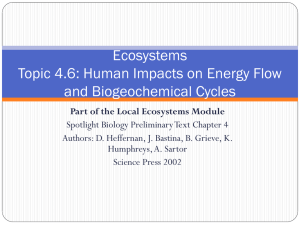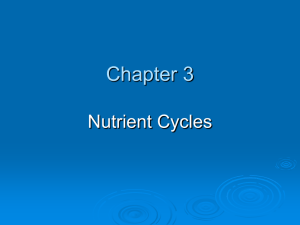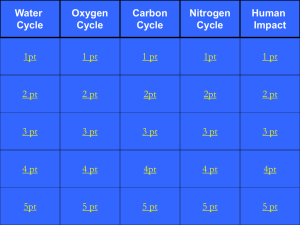Atmospheric Pollution
advertisement

Atmospheric Science and Pollution ENV 4030 (3 credits) 大气科学与污染 Textbook Atmospheric Pollution History, Science, and Regulation By Mark Z. Jacobson Cambridge 2002 Preface Atmospheric pollution = air pollution ??? Air pollution problems on the Earth are as old as the Earth itself Air is not privately owned; instead, it is common property共同财产 1. Natural air pollution: volcano eruption 火山爆发 , fumaroles火山喷气孔, natural fires自然火灾, desert dust 沙尘暴 2. Anthropogenic (manmade 人为) air pollution Manmade pollution 1. Urban smog 城市烟雾 2. Indoor air pollution (indoor air quality, IAQ) 3. Acid deposition 酸雨 4. Antarctic ozone depletion 南极臭氧层空洞 (global ozone reduction 全球臭氧损耗) 5. Global warming 全球变暖 (green house effect 温室效应) Chapter 1 Basics and History of Discovery of Atmospheric Chemicals 大气化学物的发现历史 1.6. Summary In this chapter, atoms, molecules, elements, and compounds were defined and a history of the discovery of elements and compounds of atmospheric importance was given. Only a few elements, including carbon, sulfur, and certain metals, and a few solid compound, including calcite方解石, halite石盐, and nitre硝石, were known in ancient times古代. An acceleration of the discovery of elements and compounds, particularly of gases, occurred near the end of the eighteenth century 18世 纪末 1790s. 1.6. Summary (continued) Several types of chemical reactions化学反应 occur in the air, including photolysis光分解, kinetic动力学, thermal decomposition热分解, isomerization异构化, and combination reactions化合反应. The rate of reaction反应速度 depends on the reactivity活性 and concentration of molecules. The chemical e-folding lifetime指数递减时间 of a substance is the time required for its concentration to decrease to 1/e its original value and gives an indication of the reactivity of the substance. Molecules with free electrons自由电子are called free radicals自由基 and are highly reactive 高活性. e 指数= 2.718281828…… π 圆周率 = 3.14159265……. 1.1 Basic Definitions Atmosphere 大气 = Air 空气 ???? Air is a mixture of gases and particles, both of which are made of atoms. In this section, atoms, elements, molecules, compounds, gases, and particles are defined. A gas consists of individual atoms or molecules that are separated, whereas a particle consists of aggregates集合体 of atoms or molecules bonded together. Thus, a particle is larger than a single gas atom or molecule. Second, whereas particles contain liquids or solids, gases are in their own phase state. 1.2 History of Discovery of Elements and Compounds of Atmospheric Importance 1.3 Chemical Structure and Reactivity 活性 O3 NO2 A single dot indicates that the atom has a free electron. Compounds with a free electron are called free radicals and are highly reactive. Some nonfree radicals that have a single bond are also reactive because single bonds are readily broken. Compounds with double or triple bonds are not so reactive because they are difficult to break. Noble elements惰性氣體 has no free electrons and no potential to form bonds with other elements; thus, they are chemically unreactive (inert惰性). 1.4. Chemical reactions and photoprocesses光反应 Photolysis reactions are unimolecular单分子 (involving one reactant反应物) For example NO2(g) + hv → 太阳辐射 nitrogen solar dioxide radiation wavelength 420nm NO(g) nitric oxide + O(g) atomic oxygen Chemical kinetic reactions are usually bimolecular双分子 Thermal decomposition reaction 热分解反应 . N2O5(g) + M → NO2(g) + NO3(g) + M dinitrogen pentoxide nitrogen dioxide nitrate radical M can be any molecule that provides collisional energy碰撞能量. Isomerization reaction 异构化反应 H2-C-O-O* + excited激发态 Criegee biradical M → HO*-CH=O + M excited formic acid M can be any molecule that provides collisional energy碰 撞能量. Isomers 异构体: chemical compound which has the same number and kind of atoms as another but differs in structural arrangement原 子排列 Collision reaction 碰撞反应 . CH4(g) methane . + OH(g) → CH3(g) + H2O(g) hydroxyl radical methyl radical water vapor Termolecular三分子 collision reactions are rare稀有 because the probability概率 that three gases collide simultaneously同时 发生 and change form is not large . NO2(g) + NO3(g) + M nitrogen dioxide nitrate radical N2O5(g) + M dinitrogen pentoxide M is any molecule whose purpose目的 is to carry away energy released 释放 during the reaction. Chapter 2 The Sun, the Earth, and the evolution进化 of the Earth’s atmosphere 太阳、地球 和大气的进化 2.4. Summary The sun formed from the condensation of the solar nebula太阳 星云 about 4.6 billion years ago (b.y.a) 46亿年前. Solar radiation 太阳辐射 incident on the Earth originates from the sun’s photosphere光球. The photosphere emits radiation with an effective temperature near 6,000 K (5,727 ℃). The solar spectrum consists of UV紫外线, visible可见光谱, and near–IR 近红外线 wavelength regimes. The Earth formed from the same nebula as the sun. Most of the Earth’s growth was due to asteroid 小行星 and meteorite 陨石 bombardment 碰撞. 1 billion = 10 亿 = 1,000,000,000 = one thousand million 2.4. Summary (continued) The composition of the Earth, percentage-wise, is similar to that of stony meteorites. Dense compounds高密度 and compounds with high melting points 高熔点settled to the center of the Earth. Light compounds and those with low melting points became concentrated in the crust地壳. The first atmosphere of the Earth, which consisted of hydrogen氢 and helium氦, may have been swept away吹掉 by an enhanced solar wind太阳风 during early nuclear explosions 核爆炸 in the sun. The second atmosphere, which resulted from outgassing气体释出, initially consisted of carbon dioxide, water vapor, and assorted gases混合气体. 2.4. Summary (continued) When microbes微生物 first evolved进化, they converted carbon dioxide, ammonia氨, hydrogen sulfide硫化氢 , and organic material有机物 to methane甲烷, molecular nitrogen 氮, sulfur dioxide二氧化硫 , and carbon dioxide, respectively. Oxygen-producing photosynthesis 光合作用 led to the production of oxygen氧 and ozone臭氧. The presence of oxygen resulted in the evolution of aerobic respiration需氧呼 吸, which led to a more efficient means of producing molecular nitrogen, the major constitutent要素 in today’s atmosphere (80% by volume). 2.1. The Sun and its Origin 太阳的诞生 About 15 b.y.a.(150 亿年前), all mass in the known universe 宇宙 may have been compressed 压缩 into a single point, estimated to have a density 密度 of 109 kg m-3 and a temperature of 1012 K. With the ‘Big Bang 大爆炸’, this point of mass exploded, ejecting 弹射出 material to all directions. Aggregates 聚集物 of ejected material collapsed 压缩 gravitationally引力 to form the earliest最早期 stars 恒星;. When temperatures in the cores中心 of early stars reached 10 million K, nuclear fusion 核聚变 of hydrogen into helium and higher elements began, releasing释放 energy that powered the stars. As early stars aged, they ultimately exploded, ejecting stellar 星形的 material into space. About 4.6 b.y.a., some interstellar material aggregated to form a cloudy mass, the solar nebula太阳星云. The composition of the solar nebula was the same as that of 95 percent of the other stars in the universe. Gravitational collapse of the solar nebula resulted in the formation 形成 of sun 2.2. Spectra光谱 of the radiation辐射of the Sun and the Earth Life on Earth 地球上的生命would not have evolved进化to its present state without heating (energy) by solar radiation. Radiation辐射is the emission发射or propagation传播 of energy in the form of a photon光子 or electromagnetic wave电磁波 . A photon is a particle or quantum of energy量子能量 that has no mass没有质量, no electric charge没有电荷, and an indefinite lifetime无尽生命. An electromagnetic wave is a disturbance扰乱 traveling through a medium媒体, such as air or space宇宙空间(vacuum真空), that transfer energy from one object to another without permanently 永久性 displacing取代 the medium itself. A blackbody黑体 is a body that absorbs吸收 all radiation incident on it but it also emit发射radiation with 100% efficiency. Both the Sun and Earth are very close接近 to blackbodies as no bodies are true blackbodies. 伽马射线 波长 可见光 红外线 微波 无线电波 2.3. Primordial Evolution 原始进化of the Earth and its Atmosphere 球核心的内层 2900-6371 km iron 铁 地幔 50 – 2900 km magnesium镁 地壳 0 – 50 km silicate 硅酸盐 billion years ago Fig. 2.8. Timeline of evolution on the Earth地球进化年历表 To date 迄今 2.3.2. Prebiotic atmosphere 有生命前的大气 The temperature on Earth was still very high, the atmosphere contained mainly molecular hydrogen, methane, ammonia, molecular nitrogen and hydrogen sulfide. 2.3.3. Biotic atmosphere before oxygen 无氧前的有生命大气 Abiotic synthesis非生物合成 is the process by which life is created from chemical reactions and electric discharges. Phototrophs光合菌 are organisms that obtain their energy from sunlight, such as some sulfur bacteria硫磺菌. CO2(g) + 2H2S + hydrogen sulfide hv → sunlight CH2O(aq) + H2O(aq) carbohydrate 碳水化合物 + 2S(g) sulfur Lithotrophs无机氧化生物 are organisms that obtain their energy from oxidation of inorganic compounds such as carbon dioxide, hydrogen, hydrogen sulphide, such as some methanogenic bacteria. Methane甲烷 4H2(g) + CO2(g) → CH4(g) + 2H2O(g) (anaerobic repiration无氧呼吸) Conventional heterotrophs异养生物 are organisms that obtain their energy from oxidation of organic compounds, such as humans. fermentation发酵 C6H12O6(aq) → 2C2H5OH(aq) glucose ethanol乙醇 + CO2(g) Carbon sources碳源 for organisms Autotrophs自养生物 are organisms that obtain their carbon from carbon dioxide. Photoautotrophs 光合自營性菌 derive their energy from sunlight and carbon from carbon dioxide, such as all green plants. photosynthesis光合作用 6CO2(g) + 6H2O(aq) + hv → C6H12O6(g) + 6O2(g) Lithotrophic autotrophs derive their energy and carbon from inorganic material. Lithotrophic heterotrophs derive their energy from inorganic material but their carbon source from organic material. 2.3.5. Aerobic respiration 需氧呼吸 C6H12O6(g) + 6O2(g) → 6CO2(g) + 6H2O(aq) Oxygen cycle 氧循环 The Oxygen cycle is the biogeochemical cycle that describes the movement of oxygen within and between its three main reservoirs: the atmosphere (air), the total content of biological matter within the biosphere (the global sum of all ecosystems), and the lithosphere (Earth's crust). Failures in the oxygen cycle within the hydrosphere (the combined mass of water found on, under, and over the surface of a planet) can result in the development of hypoxic zones. The main driving factor of the oxygen cycle is photosynthesis, which is responsible for the modern Earth's atmosphere and life. 2.3.6. Nitrogen cycle 氮循环 nitrogen fixation固氮作用 ammonification氨化作用 nitrification 硝化作用 denitrification反硝化作用 Most nitrogen is found in the atmosphere. The nitrogen cycle is the process by which atmospheric nitrogen is converted to ammonia or nitrates. Nitrogen is essential to all living systems. To become a part of an organism, nitrogen must first be fixed or combined with oxygen or hydrogen. Nitrogen is removed from the atmosphere by lightening and nitrogen fixing bacteria. During electrical storms, large amounts of nitrogen are oxidized and united with water to produce an acid which is carried to the earth in rain producing nitrates. Nitrates are taken up by plants and are converted to proteins. Then the nitrogen passes through the food chain from plants to herbivores to carnivores. When plants and animals eventually die, the nitrogen compounds are broken down giving ammonia (ammonification). Some of the ammonia is taken up by the plants; some is dissolved in water or held in the soil where bacteria convert it to nitrates (nitrification). Nitrates may be stored in humus or leached from the soil and carried to lakes and streams. It may also be converted to free nitrogen (denitrification) and returned to the atmosphere








